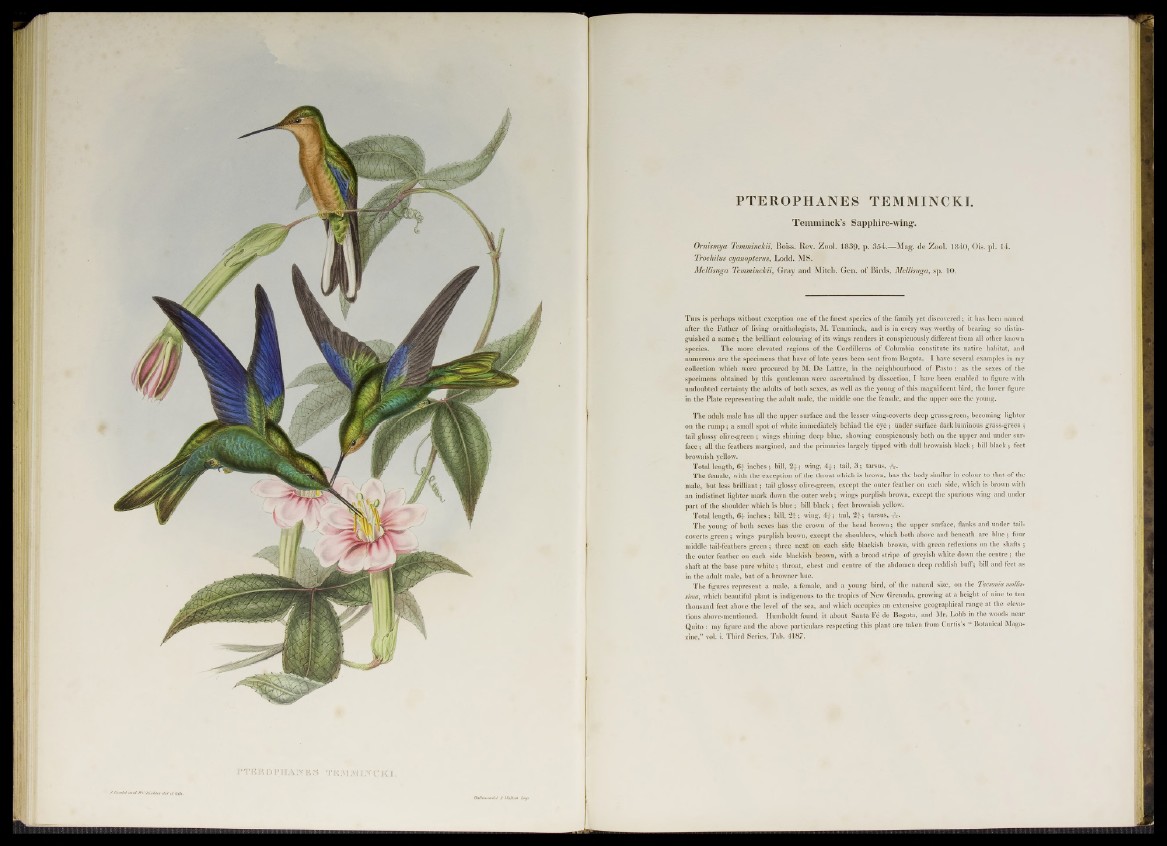
PTEROPHANES TEMMINCKJ.
Temminck’s Sapphire-wing*.
Ornisvnya TemmincJcii, Boiss. Rev. Zool. 1839, p- 354.—Mag. de Zool. 1840, Ois. pi. 14.
Trochilus cyanoptertis, Lodd. MS.
Mellisuga TemmincJcii, Gray and Mitch. Gen. o f Birds, Mellisuga, sp. 10.
T h i s is perhaps without exception one of the finest species of the family yet discovered ; it has been named
after the Father of -living ornithologists, M. Temminck, and is in every way worthy of bearing so distinguished
a name ; the brilliant colouring of its wings renders it conspicuously different from all other known
species. The more elevated regions of the Cordilleras of Columbia constitute its native habitat, and
numerous are the specimens that have of late years been sent from Bogota. I have several examples in my
collection which were procured by M. De Lattre, in the neighbourhood of Pasto: as the sexes of the
specimens obtained by this gentleman were ascertained by dissection, I have been enabled to figure with
undoubted certainty the adults of both sexes, as well as the young of this magnificent bird, the lower figure
in the Plate representing the adult male, the middle one the female, and the upper one the young.
The adult male has all the upper surface and the lesser wing-coverts deep grass-green, becoming lighter
on the rump; a small spot of white immediately behind the eye ; under surface dark luminous grass-green ;
tail glossy olive-green ; wings shining deep blue, showing conspicuously both on the upper and under surface
; all the feathers margined, and the primaries largely tipped with dull brownish black; bill black ; feet
brownish yellow.
Total length, inches ; bill, 24-; wing, ; tail, 3 ; tarsus, -¡V
The female, with the exception of the throat which is brown, has the body similar in colour to that of the
male, but less brilliant; tail glossy olive-green, except the outer feather on each side, which is brown with
an indistinct lighter mark down the outer web; wings purplish brown, except the spurious wing and under
part of the shoulder which is blue; bill black ; feet brownish yellow.
Total length, inches; bill, 2 £ ; wing, 44-; tail, 2 f ; tarsus, tV.
The young of both sexes has the crown of the head brown; the upper surface, flanks and under tail-
coverts green ; wings purplish brown, except the shoulders, which both above and beneath are blue ; four
middle tail-feathers green ; three next on each side blackish brown, with green reflexions on the shafts ;
the outer feather on each side blackish brown, with a broad stripe of greyish white down the centre; the
shaft at the base pure white; throat, chest and centre of the abdomen deep reddish buff; bill and feet as
in the adult male, but of a browner hue.
The figures represent a male, a female, and a young bird, of the natural size, on the Tacsotiia mollis-
sima, which beautiful plant is indigenous to the tropics of New Grenada, growing at a height of nine to ten
thousand feet above the level of the sea, and which occupies an extensive geographical range at the eleva*
tions above-mentioned. Humboldt found it about Santa Fe de Bogota, and Mr. Lobb in the woods near
Quito : my figure and the above particulars respecting this plant are taken from Curtis s “ Botanical Magazine,”
vol. i. Third Series, Tab. 4187.